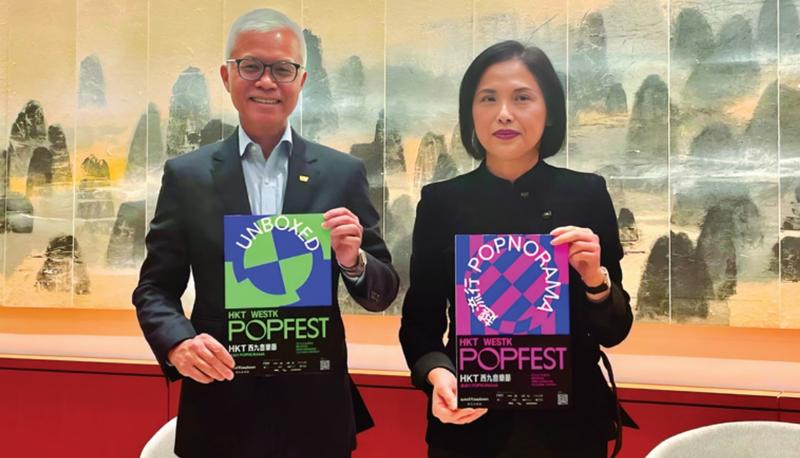 Louis Ng Chi-wa (left), director of the Hong Kong Palace Museum, and Betty Fung Ching Suk-yee, chief executive officer of the West Kowloon Cultural District Authority, present posters for HKT x WESTK POPFEST, a pop music festival to be held from March 22 to April 2. (XI TIANQI / CHINA DAILY)
Louis Ng Chi-wa (left), director of the Hong Kong Palace Museum, and Betty Fung Ching Suk-yee, chief executive officer of the West Kowloon Cultural District Authority, present posters for HKT x WESTK POPFEST, a pop music festival to be held from March 22 to April 2. (XI TIANQI / CHINA DAILY)
Hong Kong’s biggest advantage as a cultural and arts center lies in its exchanges, and the priority for the West Kowloon Cultural District is to enhance that advantage by promoting all kinds of collaborations with the Chinese mainland and overseas regions, and developing short-distance tourism products with other Guangdong-Hong Kong-Macao Greater Bay Area cities to better present the region’s cultural charm.
Chief Executive Officer of the West Kowloon Cultural District Authority Betty Fung Ching Suk-yee told media during a group interview on Friday that, compared with other international cities that are steeped in culture, such as Paris and London, Hong Kong’s most prominent cultural features are its perfect blending of Eastern and Western cultures, and the way in which its rich external ties have transformed the city into a great platform showcasing all the world’s brilliant civilizations.
To expand its impact, the West Kowloon Cultural District is in talks with Hong Kong and mainland tourism organizations to launch short-trip tour packages for one to three days, which will cover major arts and cultural attractions in the Greater Bay Area
Spearheading Hong Kong’s mission to evolve into a hub for arts and cultural exchanges between China and the rest of the world, the West Kowloon Cultural District has a lot to offer, Fung said.
ALSO READ: Bauhinia Culture Group unveils projects by HK, mainland firms
The largest cultural infrastructure in the city, the district has made great progress in both facilities and professions over the past decade. About 44 percent of its cultural facilities has been completed, covering exhibitions, performances, and involving ancient culture and contemporary art. It has also gathered a group of top experts from across the world to better deliver the district’s cultural feasts to international audiences.
Furthermore, with its excellent geographical location, which is a 10-minute walk from the West Kowloon high-speed railway station and close to Hong Kong International Airport, the district serves as a window for mainland and overseas visitors, Fung said.
Now that Hong Kong has resumed normal travel with the mainland and overseas regions, Fung said she has just wrapped up a visit to Beijing to deepen cross-border cultural collaboration. Fung said the Ministry of Culture and Tourism spoke highly of the district’s role, and pledged to fully support it in its efforts to bring outstanding mainland performers and programs, including ballet, drama, and Chinese opera to the West Kowloon Cultural District. In return, the district will consider offering some concessions when it comes to renting venues to or providing sponsorship for mainland performers.
ALSO READ:Showcase in diversity: HK culture week comes to Wuhan
To expand its impact, the cultural district is in talks with Hong Kong and mainland tourism organizations to launch short-trip tour packages for one to three days, which will cover major arts and cultural attractions in the Greater Bay Area.
It is also working with hotels and amusement parks in the city, such as the Sky 100 Hong Kong Observation Deck, Disneyland and Ocean Park, to offer more diversified experiences to tourists. The collaboration will even cover cruise tours. Fung said there are plans to arrange a guided tour service for those arriving in Hong Kong by cruise ship.
Expecting the tourism market to get busier from the May Day holidays onwards, Fung said the district hopes to receive around 600 to 700 tour groups a month in the future.
Louis Ng Chi-wa, director of the Hong Kong Palace Museum, a flagship landmark in the cultural district, said the museum’s operation has successfully reached its goal of “connectivity” — not only the connection between the past and the present, but also in terms of the dialogues between the mainland, Hong Kong and overseas regions.
ALSO READ:Culture, jobs lure graduates back to China
Since its opening in July, the museum has recorded over 900,000 visitors, about 25 percent of whom were from the mainland, especially the Greater Bay Area. The museum has also attracted membership of 17,000 people.
This year, the museum will hold two international seminars — one on archaeology, the other on culture conservation — which will bring together top experts in their areas to share their insights.
The museum is also in active discussions with mainland museums about holding a series of exhibitions focusing on the origin and development of Chinese civilization.
Reviewing the district’s development over recent years, Fung said the worst is over, and developments on various fronts have all shown positive signs. With the completion of more facilities in the future, the emerging cultural district is expected to unleash more potential in bridging the nation and the world, she said.
Contact the writers at bingcun@chinadailyhk.com


